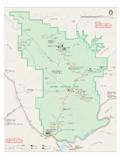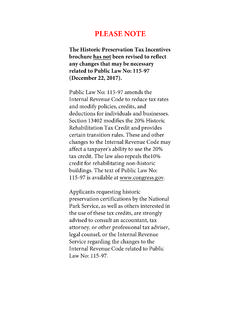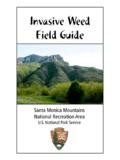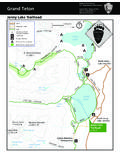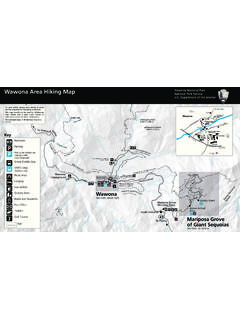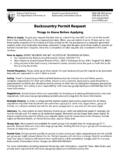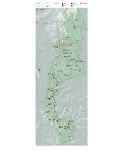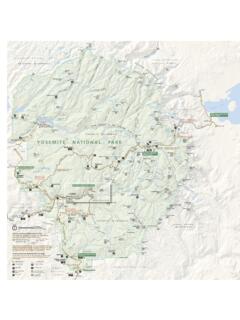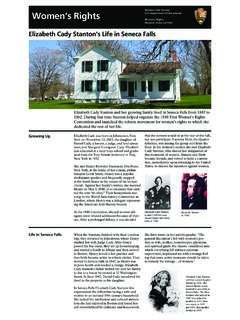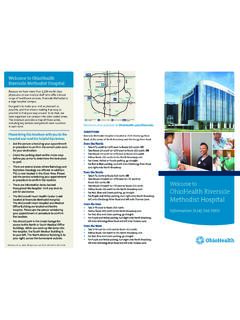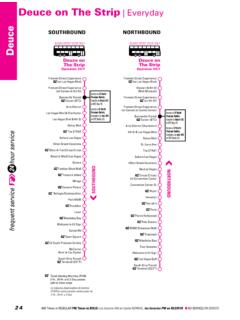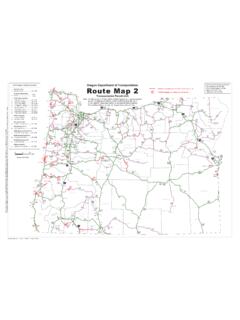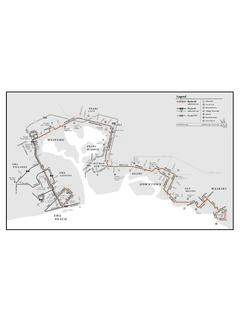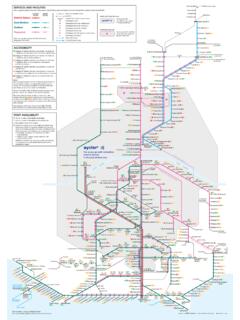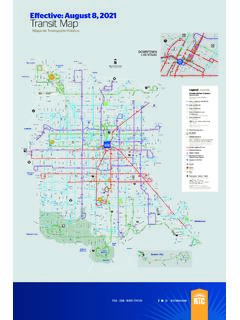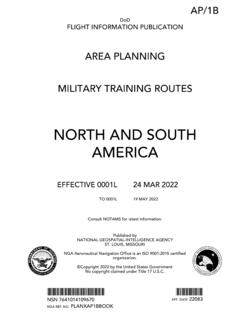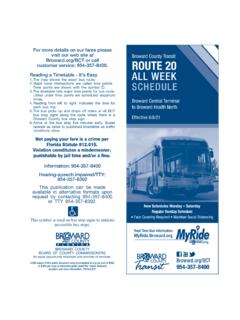Transcription of North Kaibab Trail - NPS
1 Grand Canyon National Park Service Department of the Interior Grand Canyon National Park Arizona North Kaibab Trail The North Kaibab Trail is the least visited but most difficult of the three maintained trails at Grand Canyon National Park. Almost a thousand feet higher at the trailhead than South Rim trails, hikers on the North Kaibab Trail pass through every ecosystem to be found between Canada and Mexico. At the rim, hikers will glimpse the vast maw of Bright Angel Canyon through fir trees and aspen, ferns and wildflowers. The Trail as it descends through the Redwall Limestone is blasted directly into the cliff, "literally hewn from solid rock in half-tunnel sections." Farther down, the ecology progresses so that hikers look up at the surrounding canyon walls through a blend of riparian and desert vegetation. Along the way, Roaring Springs and Ribbon Falls both offer rewarding side trips that are wonderfully juxtaposed to the often hot conditions of the main Trail .
2 Built throughout the 1920s to match the quality and grade of the South Kaibab Trail , the present-day North Kaibab Trail replaced an older route infamous for crossing Bright Angel Creek 94 times (the present-day Trail crosses only 6 times). Even though it is masterfully constructed and is a maintained Trail , don't be deceived by the apparent ease and convenience of hiking it; from beginning to end, the North Kaibab Trail has its challenges. Locations/Elevations Mileages North Kaibab trailhead (8241 ft / 2512 m) to Supai Tunnel (6800 ft / 2073 m): Supai Tunnel (6800 ft / 2073 m) to Roaring Springs (5220 ft / 1591 m): Roaring Springs (5220 ft / 1591 m) to Manzanita Rest Area (4600 ft / 1402 m): Manzanita Rest Area (4600 ft / 1402 m) to Cottonwood Campground (4080 ft / 1244 m): North Kaibab trailhead (8241 ft / 2512 m) to Cottonwood Campground (4080 ft / 1244 m): Cottonwood Campground (4080 ft / 1244 m) to Ribbon Falls (3720 ft / 1134 m): Cottonwood Campground (4080 ft / 1244 m) to Bright Angel Campground (2480 ft / 756 m): North Kaibab trailhead (8241 ft / 2512 m) to Bright Angel Campground (2480 ft / 756 m).
3 Mi ( km) mi ( km) mi ( km) mi ( km) mi ( km) mi ( km) mi ( km) 14 mi ( km) Maps Minute Quad, Phantom Ranch (USGS) Sky Terrain Trails Map, Grand Canyon (Sky Terrain) Trails Illustrated Map, Grand Canyon National Park (National Geographic) Water Sources Potable water is available at the trailhead, Supai Tunnel, Roaring Springs, the Manzanita Rest Area, Cottonwood Campground and Bright Angel Campground. All except Bright Angel Campground are seasonal only and are turned off in the fall (exact dates vary; because each station's dates depend on temperatures, the rim and Supai Tunnel are turned off first). Please note that due to random acts of erosion causing pipeline breaks, potable water stations should be considered a gift and not relied upon. Check trailhead signage prior to descending and always bring an alternative and lightweight form of water treatment.
4 From Roaring Springs to the Colorado River the Trail is never far from water that can be filtered or treated with chemicals. Campsites At-large camping is not permitted on the North Kaibab Trail ; visitors must camp in designated campgrounds: Cottonwood Campground (CCG) located near the Trail 's halfway point 7 miles from the North Kaibab trailhead, or Bright Angel Campground (CBG) located immediately adjacent to the Colorado River at the bottom of the canyon and 14 miles from the North Kaibab trailhead. Trailhead Access The North Kaibab trailhead is located 41 miles south of Jacob Lake on Highway 67 ( miles North of Grand Canyon Lodge). A small parking area offers limited parking. Transportation is available from the Grand Canyon Lodge (twice each morning; check at the lodge for times and fares) or, for those staying at North Rim Campground, it is a half-mile walk to the trailhead.
5 H ikers on a rim-to -rim hike and who have only one vehicle often use the private Trans-Canyon Shuttle (928-638-2820), which provides service between the North Rim (departs around 6 ) and the South Rim (departs around 1 ) daily from EXPERIENCE YOUR AMERICATM May 15 to October 15. North Rim park facilities (lodge, store, gas station) close on October 15, but Highway 67 remains open to vehicle traffic until winter conditions preclude access. Visitors should be prepared for road closure anytime after October 15, but often Highway 67 remains open into November. Once closed Highway 67 remains so until May 15. It is not possible to reach the trailhead by vehicle before May 15. Trail Description Resembling the Bright Angel Trail more than the South Kaibab Trail , the North Kaibab initially descends steeply down the head of a valley via a series of numerous switchbacks. After the lush verdancy and impressive views below the trailhead, the Trail reaches the distinctive Supai Tunnel, where hikers will find potable water (mid-May to mid-October) and pit toilets, but no emergency phone.
6 Switchbacks continue to the massive cliffs of Redwall Limestone, where for long stretches the Trail has been blasted out of the cliff in a half tunnel. The Redwall section is awe-inspiring in every way; fantastic exposure and views mingle with a reminiscence of an age when engineering marvels were commonplace. Where the bulk of the Trail 's descent meets the flatter bottom of Bright Angel Canyon, Roaring Springs is a worthwhile side trip. Here, water gushes forth directly out of the cliffs, cascading over moss and fern to form Bright Angel Creek (which will be a constant companion all the way to the Colorado River). This giant spring provides drinking water for every visitor and resident within Grand Canyon National Park. The water is delivered to the South Rim via a pipeline buried beneath the North Kaibab Trail (installed 1965-1970). You can see this amazing pipeline as it stretches across the Colorado River on the underside of the Bright Angel Trail 's Silver Bridge.
7 At mile an unexpected house comes into view. Once known as the Pumphouse Residence or the Aiken Residence, where for decades, artist and park employee Bruce Aiken lived, painted and worked. In years past the lucky hiker could get a refreshing cup of lemonade from one of the Aiken kids who were raised at the bottom of the Grand Canyon. The Pumphouse has since been automated and the famed house now serves as a ranger station. Nearby the house, hikers have access to the Manzanita Rest Area which affords access to Bright Angel Creek, a toilet, drinking water and shaded benches. Passing the old Aiken Residence is a welcome sign for the descending backpacker for it signals the approach of Cottonwood Campground. Those fortunate to overnight at Cottonwood Campground will have the time to explore a beautiful oasis located miles down-creek from the campground: Ribbon Falls is a true gem of the North Kaibab Trail .
8 The waterfall is located in a grotto on the west side of Bright Angel Creek, so reaching it is a short but extremely rewarding side trip. Hikers caught in the heat of the day should consider taking a siesta here from 10 to 4 Between Cottonwood Campground and Bright Angel Campground the Trail enters the Inner Gorge, a narrow canyon within the canyon where the Trail is boxed in on either side by billion year old Vishnu Schist (the contact between the top of the Vishnu Schist and the overlying Tapeats Sandstone marks the Great Unconformity where over 1 billion years of geology is missing). Though the Trail here is not challenging from the perspective of elevation profile, be aware that this is a particularly dangerous stretch of Trail during summer months. Because the entire mile stretch is at low elevation, it becomes extremely hot from early morning to late afternoon. The gorge of black rock through which the Trail passes becomes like an oven and can be compared to walking through a parking lot in Phoenix or Las Vegas in summertime.
9 Always plan on reaching Bright Angel Campground before ten in the morning. Important Notes Grand Canyon is, above all else, a place of extremes. It is necessary to take appropriate precautions depending on seasonal variations in Trail conditions. During the deep winter months, the upper section of Trail in Roaring Springs Canyon can be ice-covered and perpetually snowbound. On the North Rim, hikers need to be prepared for extreme winter conditions. During the hotter months, which can begin as early as May and last through September, it is critical that hikers have the discipline to begin their hike well before dawn or after 3 Success and enjoyment really depends on the amount of time spent in the Plan Ahead and Prepare stage (Leave No Trace). Success in the summer can be as simple as staying off the Trail and out of the sun between 10 and 4 Hiking the entire North Kaibab Trail in a single day is not recommended, particularly in summer, as it is nearly impossible to avoid hiking in the heat of the day.
10
